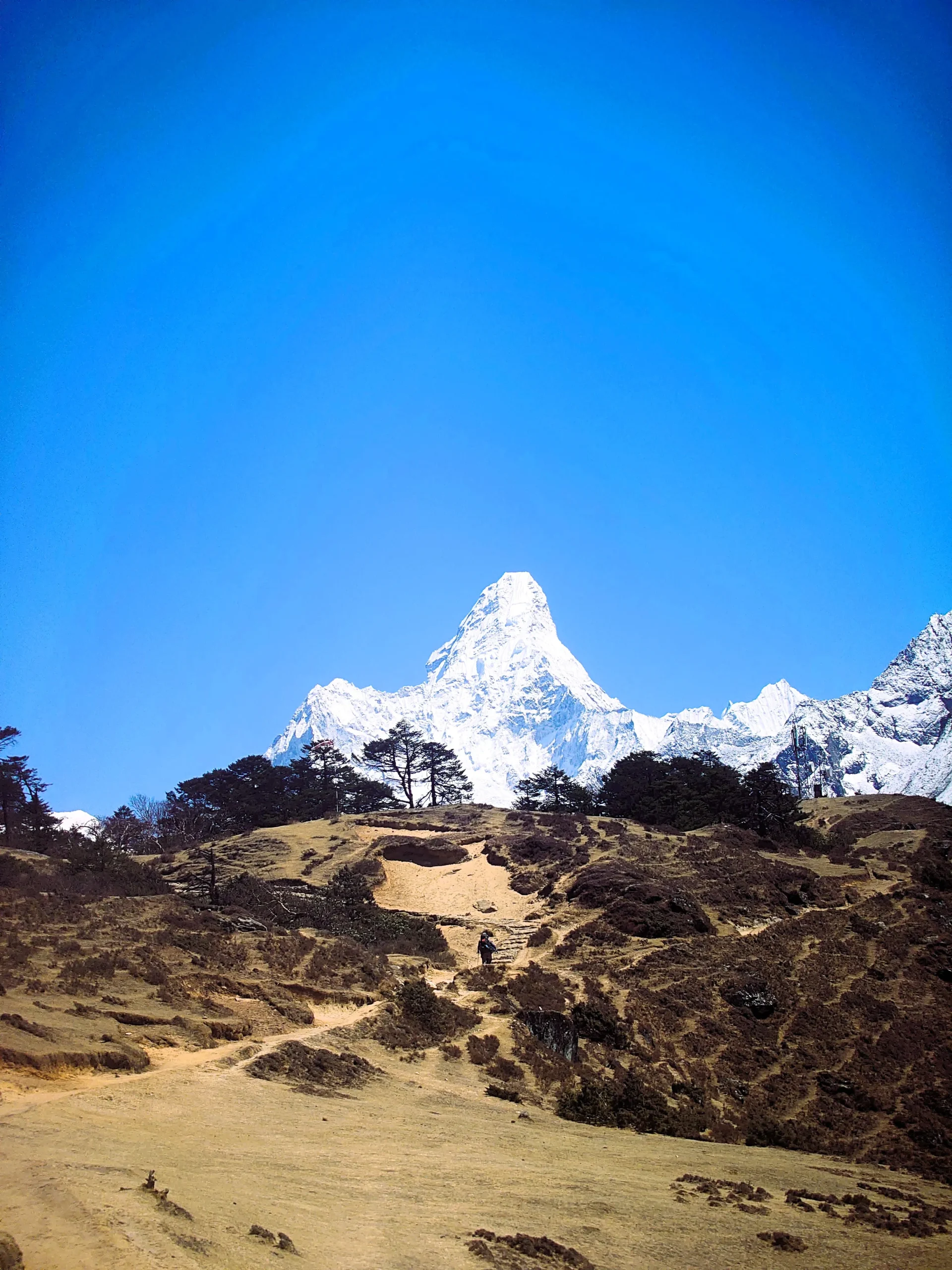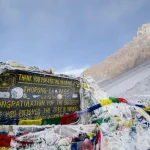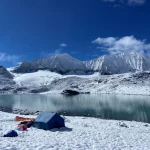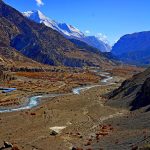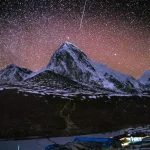Ama Dablam: The Jewel of the Himalayas – A Mountaineer’s Dream Adventure
Nestled in the heart of Nepal’s Khumbu region, Ama Dablam stands as one of the most breathtaking and iconic peaks in the Himalayas. Known as the “Matterhorn of the Himalayas,” this majestic mountain, towering at 6,812 meters (22,349 feet), captivates adventurers with its striking pyramid-like structure, sharp ridges, and cultural significance.
For mountaineers, trekkers, and nature lovers, Ama Dablam offers an unforgettable journey that blends technical climbing challenges, awe-inspiring views, and immersion in the rich Sherpa culture. This guide explores the allure of Ama Dablam, its climbing routes, preparation tips, cultural highlights, and why it’s a must-visit destination for adventure enthusiasts. For more Himalayan adventures, visit Nepal Adventure Trail.
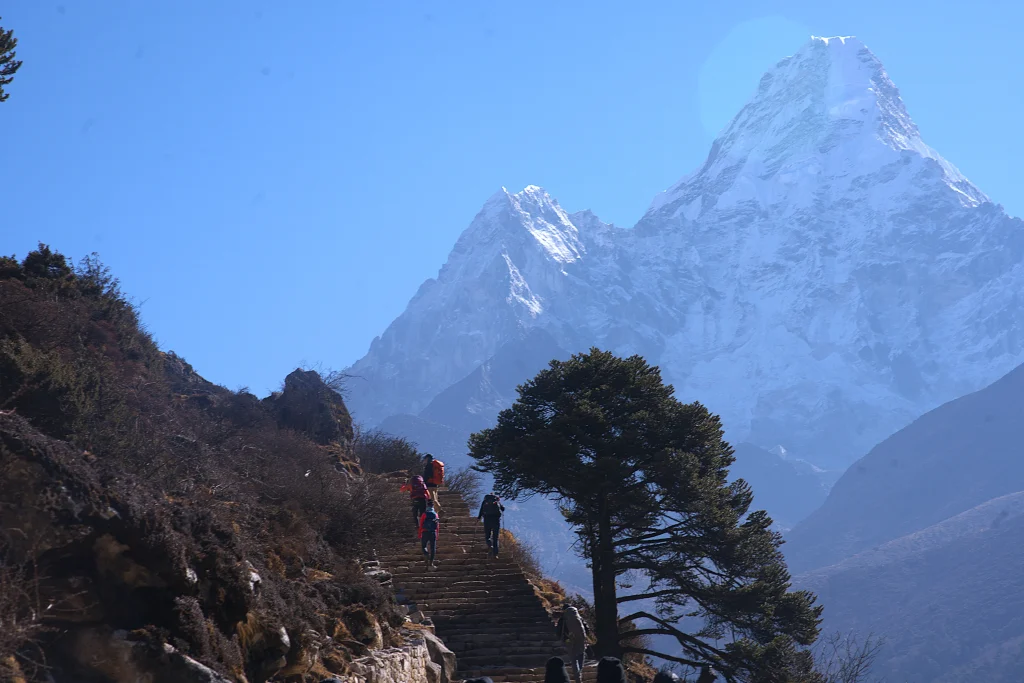
Why Choose Ama Dablam for Your Himalayan Adventure?
Ama Dablam, meaning “Mother’s Necklace” in the Sherpa language, is named for its long ridges resembling a mother’s protective arms and the hanging glacier, or “Dablam,” evoking a traditional Sherpa pendant.
This mountain is not just a visual masterpiece but also a symbol of spiritual and cultural significance for the local Sherpa community.
Its dramatic profile dominates the eastern skyline for trekkers en route to Everest Base Camp, making it a beacon for adventurers worldwide. Whether you’re an experienced mountaineer seeking a technical challenge or a trekker dreaming of Himalayan vistas, Ama Dablam promises a transformative experience.
The mountain’s allure lies in its unique blend of beauty, challenge, and accessibility. Unlike the 8,000-meter giants like Everest, Ama Dablam is a more approachable yet demanding climb, often referred to as the “mountaineer’s mountain.”
It’s Southwest Ridge, the most popular route, combines rock, ice, and snow climbing, offering a thrilling ascent with panoramic views of Everest, Lhotse, and Makalu. For those not ready to summit, trekking to Ama Dablam Base Camp provides an equally rewarding adventure with cultural immersion and stunning landscapes. Learn more about Himalayan treks at Nepal Adventure Trail’s blog.
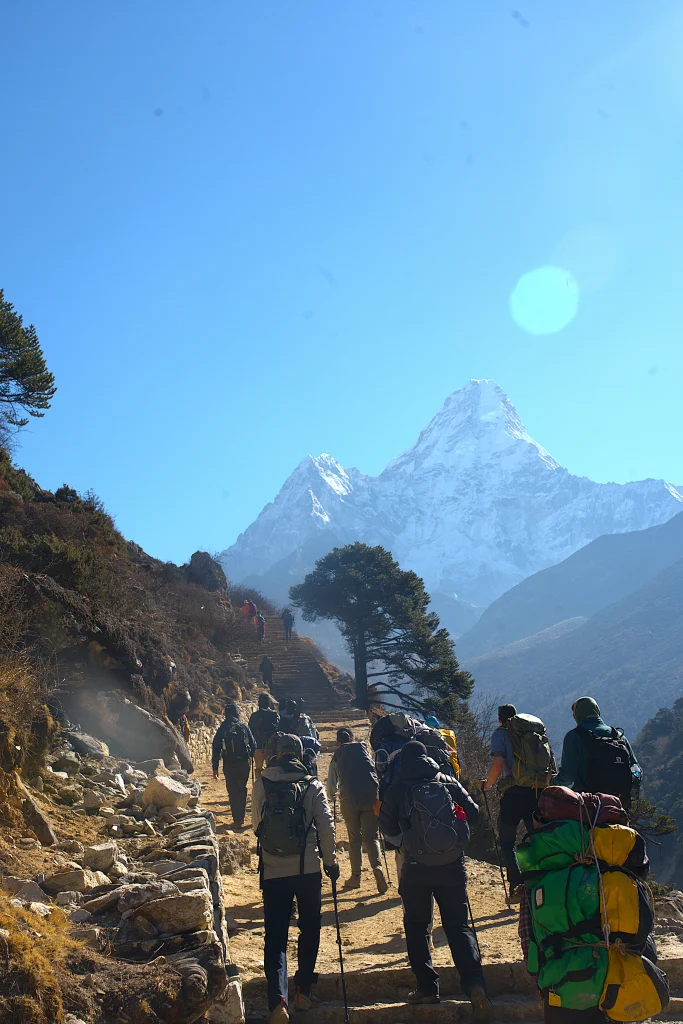
Highlights of an Ama Dablam Expedition
1. Trek to Ama Dablam Base Camp
Your journey begins with a thrilling flight from Kathmandu to Lukla, a gateway to the Himalayas. From Lukla, a 5- to 7-day trek takes you through the vibrant Sherpa town of Namche Bazaar, the spiritual Tengboche Monastery, and the picturesque village of Pangboche.
The trail winds along the Dudh Kosi River, offering breathtaking views of Ama Dablam’s shark-fin silhouette against the Himalayan skyline. At 4,600 meters (15,091 feet), Ama Dablam Base Camp is a grassy haven beneath the mountain, where climbers prepare for the ascent and trekkers soak in the serene beauty. For tips on preparing for this trek, check out Trekking Essentials.
2. Technical Climbing on the Southwest Ridge
For climbers, the Southwest Ridge is the preferred route, first summited in 1961 by a team led by Sir Edmund Hillary. This route is renowned for its technical challenges, including the near-vertical Yellow Tower and the exposed Mushroom Ridge.
Climbers navigate fixed ropes, rocky ridges, and steep ice pitches, requiring proficiency in rock and ice climbing techniques. The route typically includes two to three camps: Camp 1 at 5,800 meters (19,029 feet), Camp 2 at 6,100 meters (20,013 feet), and sometimes Camp 3 at 6,400 meters (21,000 feet), though many now skip Camp 3 due to avalanche risks from the Dablam glacier. Discover more about technical climbing in High-Altitude Climbing Guide.
3. Cultural Immersion in the Khumbu Region
The journey to Ama Dablam is as much a cultural experience as it is an adventure. The Khumbu region is home to the Sherpa people, whose warmth and hospitality enrich the journey. Visit Tengboche Monastery, the spiritual heart of the region, to witness Buddhist rituals and enjoy panoramic views. In Namche Bazaar, explore vibrant markets and the Sherpa Museum to learn about local traditions and mountaineering history.
Engaging with Sherpa culture, from tasting local cuisine like momo (dumplings) to attending prayer ceremonies, adds depth to your adventure. Read more about Sherpa culture at Sherpa Culture Insights.
4. Unparalleled Himalayan Views
From Ama Dablam’s summit or even its base camp, the views are nothing short of spectacular. On a clear day, climbers are rewarded with vistas of Mount Everest (8,848 meters), Lhotse (8,516 meters), and Makalu (8,485 meters). The broad, plateau-like summit offers a moment of triumph amidst a sea of snow-capped peaks, making the grueling ascent worthwhile. Even trekkers at lower altitudes enjoy dramatic landscapes, with Ama Dablam’s iconic profile as a constant companion.
5. Unique Activities for Non-Climbers
For those not aiming for the summit, the trek to Ama Dablam Base Camp offers plenty of activities. Hike to nearby viewpoints like Everest View Hotel for stunning panoramas, or explore the Chukhung Valley, surrounded by towering peaks. Photography enthusiasts will find endless inspiration in the mountain’s dramatic ridges and the vibrant prayer flags fluttering in the Himalayan breeze. For more non-climbing activities, visit Himalayan Trekking Adventures.
Ama Dablam Expedition Itinerary (25-32 Days)
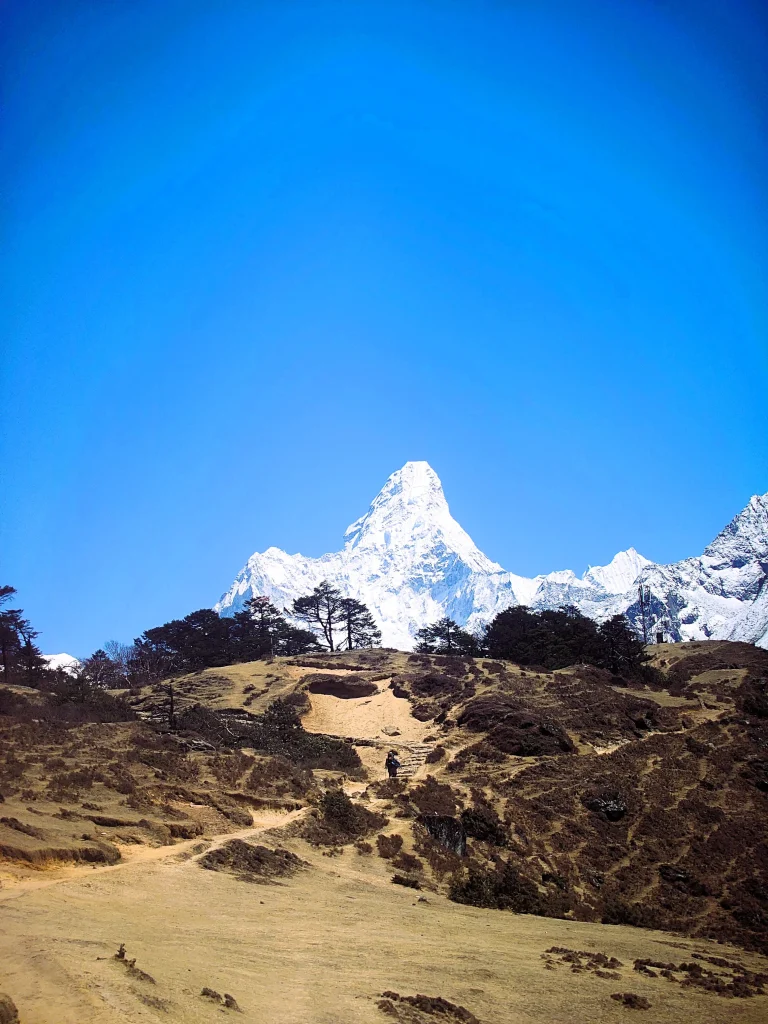
Here’s a sample itinerary for an Ama Dablam climbing expedition, blending adventure, acclimatization, and cultural exploration:
Day 1-2: Arrival in Kathmandu
Arrive at Tribhuvan International Airport in Kathmandu and spend a day exploring cultural landmarks like Boudhanath Stupa and Pashupatinath Temple. Meet your expedition team, finalize permits, and prepare gear. Learn about Kathmandu’s cultural sites at Kathmandu Travel Guide.
Day 3-7: Trek to Ama Dablam Base Camp
Fly to Lukla (2,860 meters) and trek through Phakding, Namche Bazaar, Tengboche, and Pangboche. Acclimate in Namche and Dingboche to adjust to the altitude. Reach Ama Dablam Base Camp (4,600 meters), where you’ll set up camp and undergo climbing training, including fixed-rope techniques and ice axe handling.
Day 8-10: Acclimatization and Training
Spend time at Base Camp for acclimatization hikes and technical training. Make a rotation to Camp 1 (5,800 meters) to familiarize yourself with the route, then return to Base Camp for rest. For acclimatization tips, see Altitude Sickness Prevention.
Day 11-20: Summit Push
Begin the ascent with climbs to Camp 1 and Camp 2, navigating technical sections like the Yellow Tower. Rest and monitor weather conditions before the final summit push. The climb to the summit (6,812 meters) involves 10+ hours of strenuous effort, often starting from Camp 2 to avoid risks at Camp 3. Celebrate at the summit with unparalleled views before descending to Base Camp.
Day 21-25: Return Trek and Departure
Trek back to Lukla via Pangboche and Namche Bazaar, reflecting on your adventure. Fly to Kathmandu and enjoy a celebratory dinner before departing home, carrying memories of a lifetime.
Preparing for Ama Dablam: Tips for Success
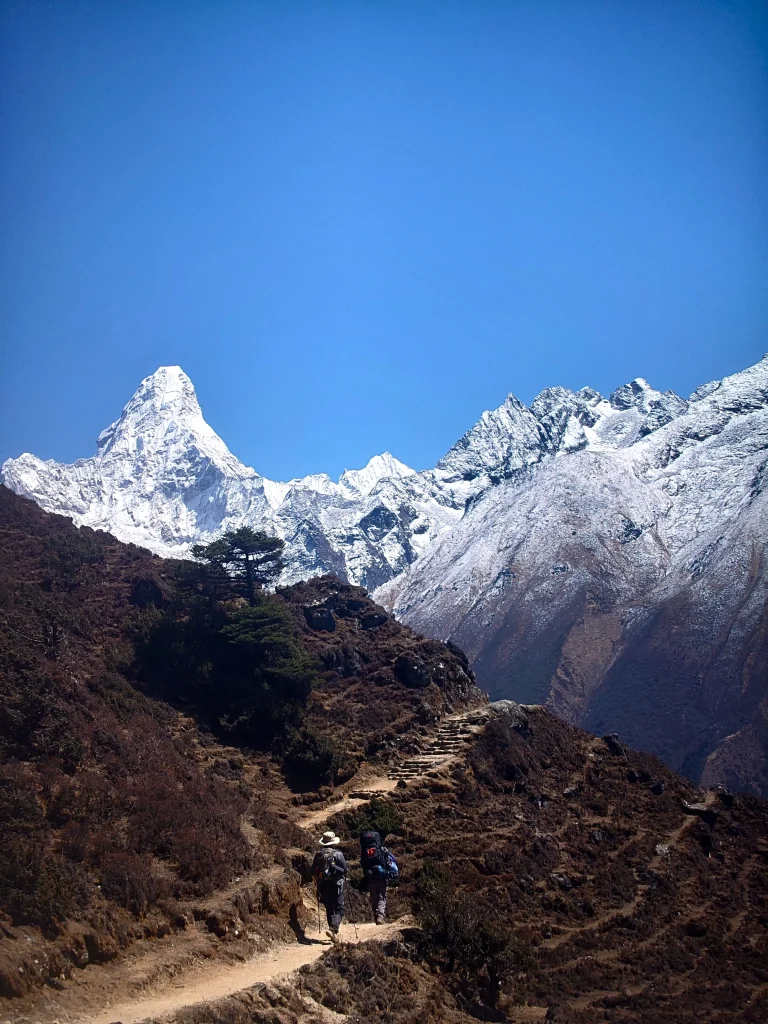
Physical and Technical Training
Ama Dablam is a technical climb graded TD/5, requiring excellent fitness and proficiency in rock, ice, and mixed climbing. Train for 6-12 months with a focus on:
- Cardiovascular Fitness: Running, cycling, or hiking to build endurance.
- Strength Training: Core, leg, and upper-body exercises to handle heavy packs and steep ascents.
- Technical Skills: Practice rock climbing, ice axe use, and rope management. Consider training climbs like Island Peak for high-altitude experience.
Acclimatization
Proper acclimatization is critical to avoid altitude sickness. Follow the “climb high, sleep low” principle, making gradual ascents and rotations to higher camps. Spend time in the Khumbu Valley to adapt to reduced oxygen levels.
Essential Gear
Pack high-quality gear, including:
- Climbing Equipment: Ice axe, crampons, helmet, harness, carabiners, and fixed ropes.
- Clothing: Layered clothing (base layers, fleece, down parka, waterproof shell), mountaineering boots, and gloves.
- Camping Gear: High-altitude sleeping bag, sleeping pad, and a 65-liter backpack.
Permits and Logistics
Climbers need a Sagarmatha National Park permit, a TIMS card, and an Ama Dablam climbing permit, typically arranged by expedition operators. A certified guide is mandatory for peaks above 6,000 meters in Nepal. Learn more at Nepal Trekking Permits.
Best Time to Climb
The optimal seasons are spring (April-May) for quieter trails and fresh snow, and autumn (September-November) for stable weather and clear skies. Avoid the monsoon season (June-August) due to heavy rain and poor visibility.
Safety Considerations
Ama Dablam is a challenging climb with risks, including avalanches, falls, and altitude sickness. The 2006 avalanche at Camp 3, which killed six climbers, led to changes in camp placements. Modern expeditions often skip Camp 3 to minimize exposure to the Dablam glacier.
Ensure your team monitors weather forecasts, carries emergency equipment (satellite phones, oxygen, medical kits), and employs experienced Sherpa guides. For safety tips, visit Climbing Safety Guide.
Inclusions and Exclusions
Inclusions
- Accommodation: Stays in Kathmandu hotels and teahouses during the trek, plus tents at Base Camp.
- Meals: Breakfast, lunch, and dinner during the trek and expedition.
- Transportation: Flights to/from Lukla and ground transfers in Kathmandu.
- Guides and Porters: Experienced Sherpa guides and porters for support.
- Permits: All necessary climbing and trekking permits.
Exclusions
- International Flights: Airfare to/from Kathmandu.
- Personal Expenses: Snacks, drinks, souvenirs, and personal gear.
- Insurance: Mandatory travel insurance covering high-altitude rescue and evacuation.
- Unforeseen Costs: Expenses due to weather delays, medical emergencies, or itinerary changes.
FAQs
1. How difficult is the Ama Dablam climb?
Ama Dablam is a technical climb (TD/5) requiring prior high-altitude and technical climbing experience. Proficiency in rock and ice climbing is essential.
2. What is the best time to climb Ama Dablam?
Spring (April-May) and autumn (September-November) offer the best weather conditions. Autumn is the most popular season for stable skies.
3. Do I need a guide to climb Ama Dablam?
Yes, Nepalese law mandates a guide for peaks above 6,000 meters. A certified guide enhances safety and success.
4. How long does an Ama Dablam expedition take?
A typical expedition lasts 25-32 days, including trekking, acclimatization, and the summit push.
5. Can non-climbers visit Ama Dablam?
Yes, trekking to Ama Dablam Base Camp is a rewarding option for non-climbers, offering stunning views and cultural experiences. Explore more at Ama Dablam Base Camp Trek.
Why Ama Dablam is Unforgettable
Ama Dablam is more than a mountain; it’s a journey that tests your limits and rewards you with unparalleled beauty and cultural richness.
Whether you’re scaling its technical ridges or trekking through the Khumbu Valley, the experience is transformative. From the spiritual serenity of Tengboche Monastery to the thrill of summiting one of the world’s most iconic peaks, Ama Dablam offers a perfect blend of adventure, culture, and natural splendor.
Ready to embark on this Himalayan adventure? Contact Nepal Adventure Trail to plan your journey. Pack your gear, prepare your spirit, and let Ama Dablam etch an unforgettable tale into your heart.
